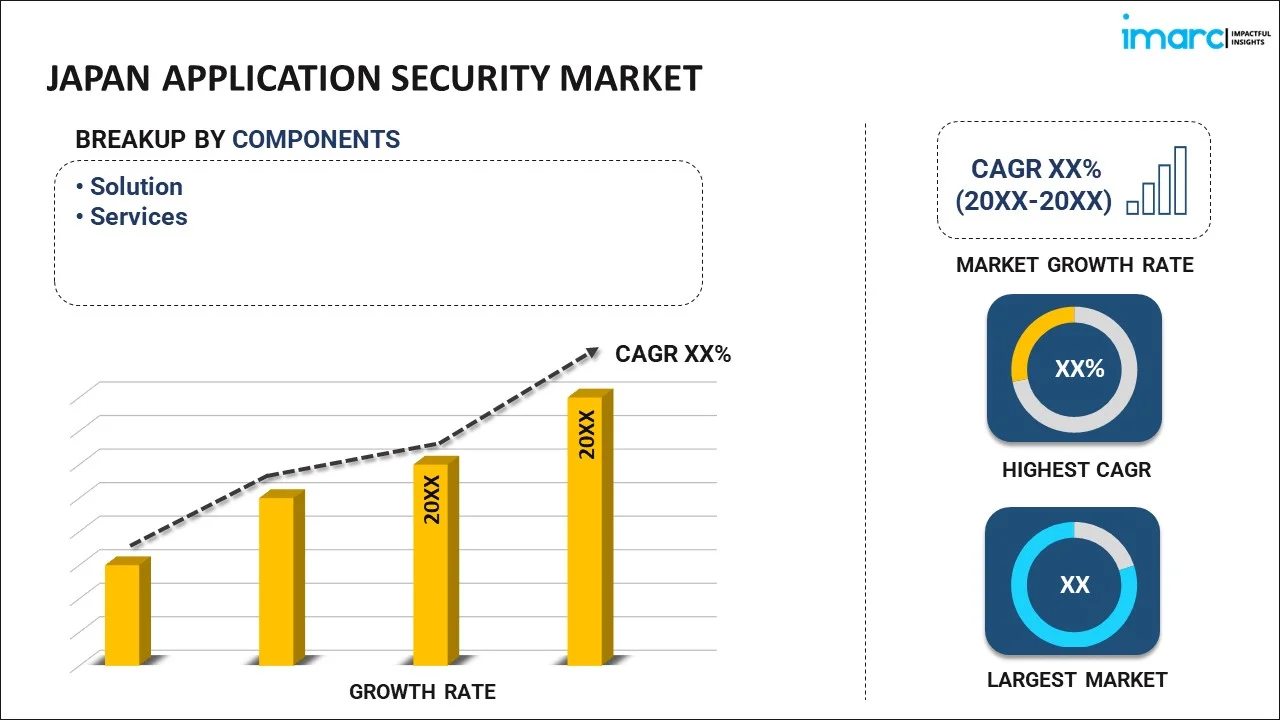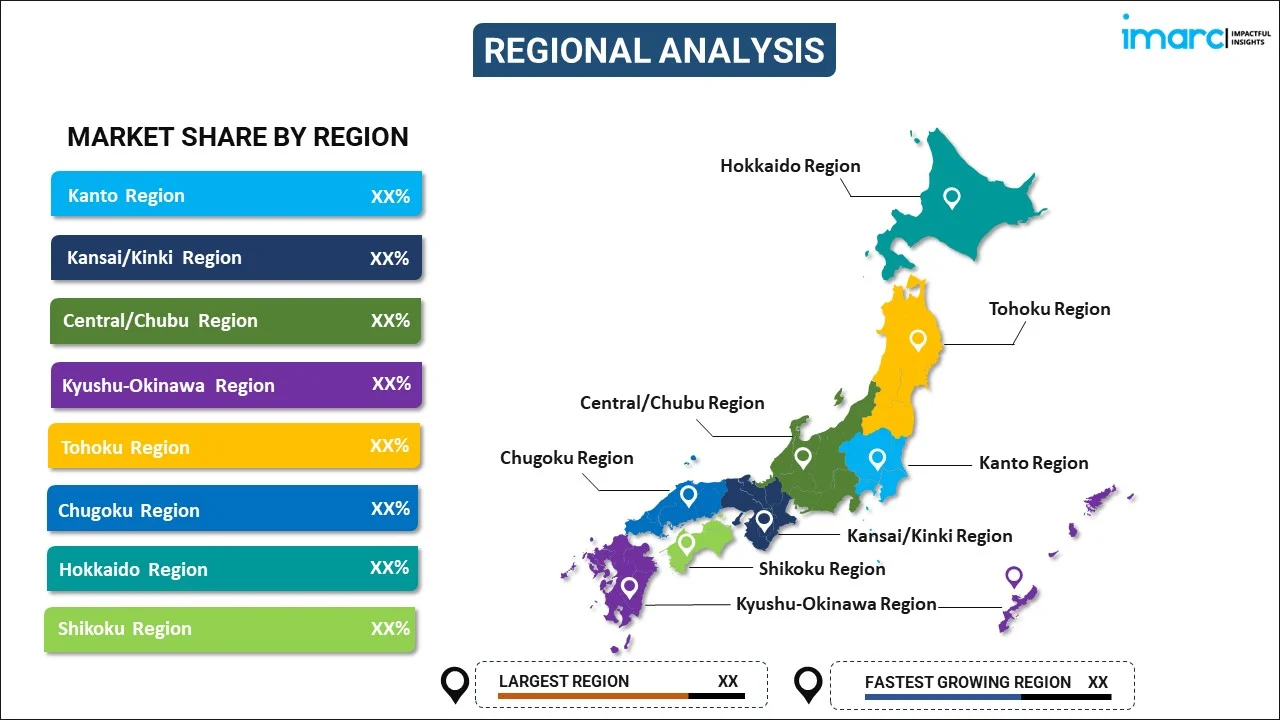
Japan Application Security Market Report by Component (Solution, Services), Type (Web Application Security, Mobile Application Security), Testing Type (Static Application Security Testing (SAST), Dynamic Application Security Testing (DAST), Interactive Application Security Testing (IAST), Runtime Application Self-Protection (RASP)), Deployment Mode (Cloud-based, On-premises), Organization Size (Large Enterprises, Small and Medium-sized Enterprises), Industry Vertical (BFSI, Healthcare, IT and Telecom, Manufacturing, Government and Public Sector, Retail and E-Commerce, and Others), and Region 2026-2034
Market Overview:
Japan application security market size reached USD 622.8 Million in 2025. Looking forward, IMARC Group expects the market to reach USD 1,643.7 Million by 2034, exhibiting a growth rate (CAGR) of 11.39% during 2026-2034. The rising number of online fraudulent activities, coupled with the inflating need for enhanced software to protect software and critical data, is primarily driving the market growth.
|
Report Attribute
|
Key Statistics
|
|---|---|
|
Base Year
|
2025
|
|
Forecast Years
|
2026-2034
|
|
Historical Years
|
2020-2025
|
| Market Size in 2025 | USD 622.8 Million |
| Market Forecast in 2034 | USD 1,643.7 Million |
| Market Growth Rate 2026-2034 | 11.39% |
Application security encompasses the practice of creating, incorporating, and scrutinizing components within diverse applications to mitigate security weaknesses. It encompasses several protective layers, including authentication, authorization, encryption, and logging, to thwart unauthorized access by third parties, unauthorized alterations, and the potential for irregular activities. Consequently, this aids businesses in safeguarding client data, streamlining operations, and sustaining the lifecycle of the application. Presently, it is commercially accessible through diverse testing methodologies, including runtime application self-protection (RASP), interactive application security testing (IAST), and dynamic application security testing (DAST).
Japan Application Security Market Trends:
The growth of the application security market in Japan is being driven by the widespread adoption of security solutions that are flexible, durable, and cost-effective across various industry sectors, including information technology (IT), telecommunications, e-commerce, banking, financial services, insurance (BFSI), and public sectors. This adoption is primarily in response to the increasing incidence of online fraudulent activities. Furthermore, governments in various countries have taken proactive measures to enhance cybersecurity by implementing security identifiers (IDs) to verify user identities, which supports the market's growth. Additionally, the sudden shift to remote work (work from home, or WFH) and the implementation of the bring your own device (BYOD) corporate model due to the COVID-19 pandemic and subsequent lockdowns have heightened the risks of data vulnerabilities. This, in turn, serves as another factor driving market growth. Furthermore, there is a growing need to secure every phase of the software development lifecycle (SDLC) to protect software and critical data, which contributes to the market's expansion. Additionally, the extensive use of personal smart devices, such as smartphones, laptops, tablets, and smart wearables, for accessing various applications and organizational information is expected to create a positive outlook for the market in the coming years.
Japan Application Security Market Segmentation:
IMARC Group provides an analysis of the key trends in each segment of the market, along with forecasts at the country level for 2026-2034. our report has categorized the market based on component, type, testing type, deployment mode, organization size, and industry vertical.
Component Insights:

To get more information on this market, Request Sample
- Solution
- Services
The report has provided a detailed breakup and analysis of the market based on the component. This includes solution and services.
Type Insights:
- Web Application Security
- Mobile Application Security
A detailed breakup and analysis of the market based on the type have also been provided in the report. This includes web application security and mobile application security.
Testing Type Insights:
- Static Application Security Testing (SAST)
- Dynamic Application Security Testing (DAST)
- Interactive Application Security Testing (IAST)
- Runtime Application Self-Protection (RASP)
The report has provided a detailed breakup and analysis of the market based on the testing type. This includes static application security testing (SAST), dynamic application security testing (DAST), interactive application security testing (IAST), and runtime application self-protection (RASP).
Deployment Mode Insights:
- On-premises
- Cloud-based
A detailed breakup and analysis of the market based on the deployment mode have also been provided in the report. This includes on-premises and cloud-based.
Organization Size Insights:
- Large Enterprises
- Small and Medium-sized Enterprises
The report has provided a detailed breakup and analysis of the market based on organization size. This includes large enterprises and small and medium-sized enterprises.
Industry Vertical Insights:
- BFSI
- Healthcare
- IT and Telecom
- Manufacturing
- Government and Public Sector
- Retail and E-Commerce
- Others
A detailed breakup and analysis of the market based on the industry vertical have also been provided in the report. This includes BFSI, healthcare, it and telecom, manufacturing, government and public sector, retail and e-commerce, and others.
Regional Insights:

- Kanto Region
- Kansai/Kinki Region
- Central/ Chubu Region
- Kyushu-Okinawa Region
- Tohoku Region
- Chugoku Region
- Hokkaido Region
- Shikoku Region
The report has also provided a comprehensive analysis of all the major regional markets, which include Kanto Region, Kansai/Kinki Region, Central/ Chubu Region, Kyushu-Okinawa Region, Tohoku Region, Chugoku Region, Hokkaido Region, and Shikoku Region.
Competitive Landscape:
The market research report has also provided a comprehensive analysis of the competitive landscape. Competitive analysis such as market structure, key player positioning, top winning strategies, competitive dashboard, and company evaluation quadrant has been covered in the report. Also, detailed profiles of all major companies have been provided.
Latest News and Developments:
- In July 2025, Internet Initiative Japan Inc. (IIJ) announced that its Cloud Proxy Service and Managed WAF Service were registered under Japan's ISMAP program. These cloud-based services meet government security standards, enabling safer use by public agencies. The certification was granted on June 30, 2025.
- In April 2025, SB Technology began offering the Cloudflare WAF (Web Application Firewall) service in Japan to enhance corporate web application security. The solution provides real-time threat detection using ML and defends against DDoS and bot attacks. This launch supports growing cybersecurity needs amid increasing digital transformation.
- In November 2024, DerSecur announced a strategic partnership with Japan’s TOYO Corporation to launch the DerScanner application security platform in Japan. This AI-driven tool helped organizations detect and fix software vulnerabilities early, enhancing cybersecurity across industries.
- In March 2024, NTT DATA Japan announced a global strategic partnership with Synopsys Software Integrity Group to enhance its application security services. This collaboration integrated Synopsys’ advanced security tools and advisory services to improve software supply chain protection and risk management.
Japan Application Security Market Report Coverage:
| Report Features | Details |
|---|---|
| Base Year of the Analysis | 2025 |
| Historical Period | 2020-2025 |
| Forecast Period | 2026-2034 |
| Units | Million USD |
| Scope of the Report | Exploration of Historical and Forecast Trends, Industry Catalysts and Challenges, Segment-Wise Historical and Predictive Market Assessment:
|
| Components Covered | Solution, Services |
| Types Covered | Web Application Security, Mobile Application Security |
| Testing Types Covered | Static Application Security Testing (SAST), Dynamic Application Security Testing (DAST), Interactive Application Security Testing (IAST), Runtime Application Self-Protection (RASP) |
| Deployment Modes Covered | Cloud-based, On-premises |
| Organization Sizes Covered | Large Enterprises, Small and Medium-sized Enterprises |
| Industry Verticals Covered | BFSI, Healthcare, IT and Telecom, Manufacturing, Government and Public Sector, Retail and E-Commerce, Others |
| Regions Covered | Kanto Region, Kansai/Kinki Region, Central/ Chubu Region, Kyushu-Okinawa Region, Tohoku Region, Chugoku Region, Hokkaido Region, Shikoku Region |
| Customization Scope | 10% Free Customization |
| Post-Sale Analyst Support | 10-12 Weeks |
| Delivery Format | PDF and Excel through Email (We can also provide the editable version of the report in PPT/Word format on special request) |
Key Benefits for Stakeholders:
- IMARC’s industry report offers a comprehensive quantitative analysis of various market segments, historical and current market trends, market forecasts, and dynamics of the Japan application security market from 2020-2034.
- The research report provides the latest information on the market drivers, challenges, and opportunities in the Japan application security market.
- Porter's five forces analysis assist stakeholders in assessing the impact of new entrants, competitive rivalry, supplier power, buyer power, and the threat of substitution. It helps stakeholders to analyze the level of competition within the Japan application security industry and its attractiveness.
- Competitive landscape allows stakeholders to understand their competitive environment and provides an insight into the current positions of key players in the market.
Key Questions Answered in This Report
The application security market in Japan was valued at USD 622.8 Million in 2025.
The Japan application security market is projected to exhibit a CAGR of 11.39% during 2026-2034, reaching a value of USD 1,643.7 Million by 2034.
The Japan application security market is driven by rising cyber threats, stricter regulatory requirements, and the growing adoption of cloud-based services. Businesses are prioritizing secure software development and real-time threat detection. The shift towards remote work and digital transformation across sectors is catalyzing the demand for application-layer protection, encouraging investment in advanced security tools and practices.
Need more help?
- Speak to our experienced analysts for insights on the current market scenarios.
- Include additional segments and countries to customize the report as per your requirement.
- Gain an unparalleled competitive advantage in your domain by understanding how to utilize the report and positively impacting your operations and revenue.
- For further assistance, please connect with our analysts.
 Request Customization
Request Customization
 Speak to an Analyst
Speak to an Analyst
 Request Brochure
Request Brochure
 Inquire Before Buying
Inquire Before Buying




.webp)




.webp)












